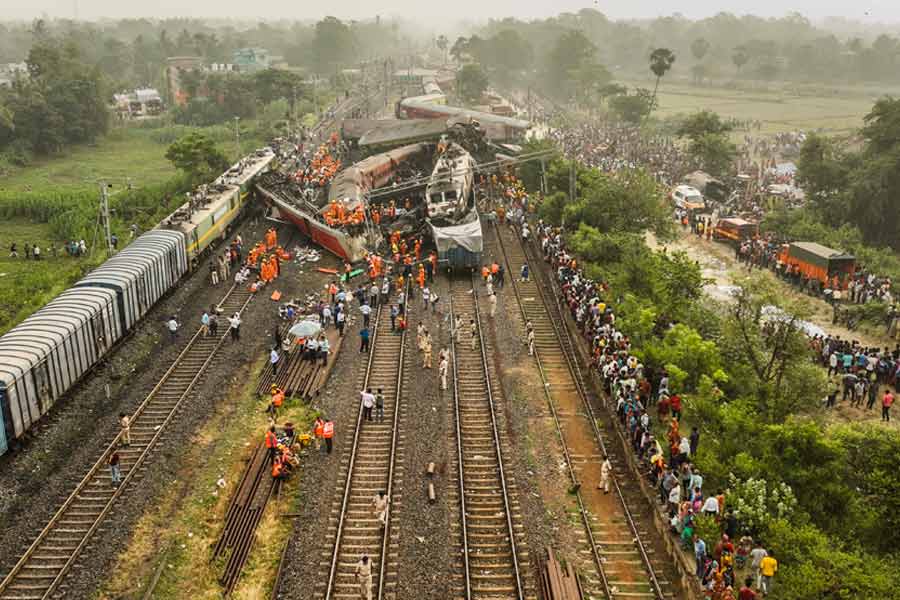Residents of Bahanaga near Balasore queued up to donate blood for the victims of the triple-train accident, worked through the night to help retrieve mangled bodies from the wrecked compartments, ferried victims to hospitals and provided food and water to the survivors.
They guided relatives of the passengers to Bahanaga High School where bodies have been kept for identification. They were also seen consoling the relatives. The locals worked overnight and defied scorching heat on Saturday to help the rescue teams.
Youths queued up in hospitals to donate blood for those injured. “If our blood can save someone’s life, no other thing can bring cheer and happiness to our lives. People are reaching the hospitals in numbers to donate blood. It is becoming tough for the administration to control the flow of people,” said Sashikanta Behera, a local journalist.
Chief secretary P.K. Jena said in a tweet: “500 units of blood collected overnight here at Balasore. 900 units in stock at present. This will help in treating the accident victims. I’m personally indebted & grateful to all the volunteers who’ve donated blood for a noble cause. Odisha today observed a state mourning and no state celebration took place across the state.”
Jayanta Kumar Behera, another local, said: “We had never seen such a tragedy in our life. People are coming from different parts of the district to extend help to the injured. We rushed to rescue the passengers trapped in the bogies. Mutilated hands and legs were strewn all over the place. People were crying for help. It’s a heart-wrenching situation. People cried inconsolably at the Bahanaga High School where the bodies were kept for identification. We have been consoling them and giving them something to drink.”
Anita Das, whose husband died in the accident, said when she had spoken to him in the evening, he had said the Bangalore-Howrah Express was crowded. “When I called him, he said there was a huge rush on the train. When I called at night, the phone was switched off. When I called again in the morning, someone picked up and said my husband had died in the train accident,” Das said.
A survivor, who was being consoled by the locals, said he was travelling with two of his friends on the Bangalore-Howrah Express. “We were travelling in a general compartment. We lost one of our friends, We don’t know how to face his family,” said the youth from Patna.
The Balasore district hospital and the Soro hospital where the injured have been rushed are bursting at their seams as the huge flow of survivors has crammed every room, with patients spilling onto corridors.
Till mid-day, some 526 railway accident victims had been admitted to the Balasore district hospital.
Dr Mrutunjay Mishra, additional district medical officer at the hospital, said: “I am in the profession for many decades, but have never seen such chaos in my life…. All of a sudden, 251 injured people were rushed into our hospital and we were not at all prepared. Our staff worked through the night.”
“We were surprised as a large number of youths made a beeline to donate blood here. We collected around 500 units of blood overnight,” he added. More than 2,000 people gathered at the Balasore Medical College and Hospital at night to help the injured, and many also donated blood, officials said.
The morgue at the hospital was a pile of shrouded bodies, many of them yet to be identified.
Jagdeb Patra who is in hospital with fractures in both hands, said he was travelling to Chennai.
Mukesh Pandit, another injured passenger from Jharkhand who was travelling to Chennai in the Coromandel Express, said he “never realised when the accident occurred”. “When I regained consciousness, I was in extreme pain,” he said.
Residents helped National Disaster Response Force (NDRF) and fire brigade officials through the night. Seven NDRF teams, five Odisha Disaster Rapid Action Force units and 24 fire and emergency units were involved in the operation. They used plasma cutters, gas torches and electric cutters to pull out the survivors and the dead from the derailed trains.
More than 200 ambulances, 50 buses and 45 mobile units were deployed. Around 1,200 personnel were engaged in the operation. Two teams of doctors from AIIMS, Bhubaneswar, were sent to Cuttack and Balasore to help the Odisha government’s medical teams treat those injured.










